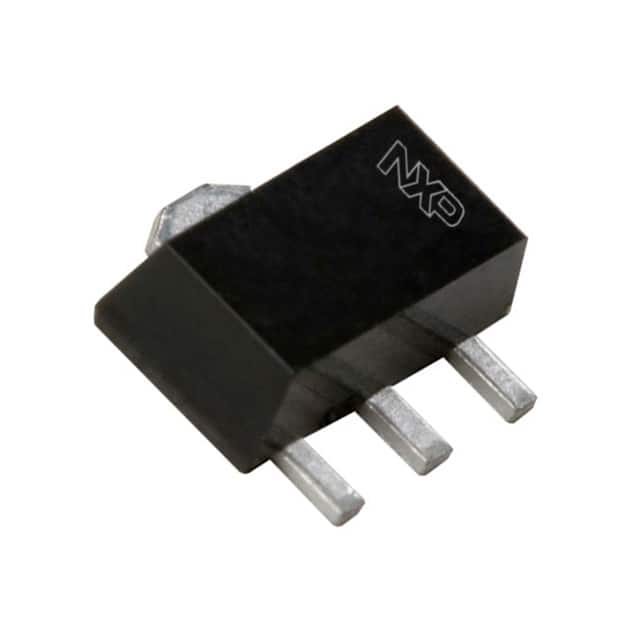BSR41F - Product Overview and Specifications
Introduction
The BSR41F is a high-frequency, low-noise NPN bipolar junction transistor (BJT) belonging to the category of electronic components. This transistor is widely used in various applications due to its excellent characteristics and performance.
Basic Information Overview
- Category: Electronic Component
- Use: Amplification and Switching in High-Frequency Circuits
- Characteristics: Low Noise, High Frequency, NPN Type
- Package: SOT-23
- Essence: High-Frequency Signal Amplification
- Packaging/Quantity: Typically available in reels of 3000 units
Specifications
- Type: NPN Bipolar Junction Transistor
- Maximum Collector-Base Voltage (V_CB): 75V
- Maximum Collector Current (I_C): 100mA
- DC Current Gain (h_FE): 100 - 400
- Transition Frequency (f_T): 6GHz
- Noise Figure (NF): 1dB
Detailed Pin Configuration
The BSR41F transistor has three pins: 1. Emitter (E): Connected to the ground or the common reference point. 2. Base (B): Input terminal for controlling the transistor's operation. 3. Collector (C): Output terminal for amplified signal.
Functional Features
- High-Frequency Amplification: The BSR41F is designed to amplify high-frequency signals with low noise, making it suitable for use in radio frequency (RF) circuits and other high-frequency applications.
- Low Power Consumption: It operates efficiently with low power consumption, making it suitable for battery-powered devices.
- Small Package Size: The SOT-23 package allows for compact circuit designs, ideal for space-constrained applications.
Advantages and Disadvantages
Advantages
- Excellent high-frequency performance
- Low noise figure
- Compact SOT-23 package
- Wide operating temperature range
Disadvantages
- Limited maximum collector current compared to some alternative models
- Moderate DC current gain range
Working Principles
The BSR41F operates based on the principles of bipolar junction transistors, where the input current at the base terminal controls the flow of current between the collector and emitter terminals. In high-frequency applications, it provides amplification while maintaining low noise levels.
Detailed Application Field Plans
The BSR41F is commonly used in the following applications: - RF Amplifiers - Oscillators - Mixers - Low-Noise Preamplifiers
Detailed and Complete Alternative Models
Some alternative models to the BSR41F include: - BFR93A - MMBTH10 - NE46134
In conclusion, the BSR41F NPN transistor offers high-frequency amplification with low noise, making it suitable for various RF and high-frequency applications. Its compact package and excellent performance make it a popular choice among designers working on space-constrained and low-noise circuit designs.
Word Count: 410
Senaraikan 10 soalan dan jawapan biasa yang berkaitan dengan aplikasi BSR41F dalam penyelesaian teknikal
What is BSR41F?
- BSR41F is a common PNP silicon transistor used in various technical solutions.
What are the typical applications of BSR41F?
- BSR41F is commonly used in audio amplification, switching, and signal processing circuits.
What are the key electrical characteristics of BSR41F?
- The BSR41F transistor typically has a collector-emitter voltage (Vce) of 80V, a collector current (Ic) of 100mA, and a power dissipation (Ptot) of 500mW.
How do I identify the pin configuration of BSR41F?
- The pinout of BSR41F is typically available in its datasheet, with the collector, base, and emitter pins clearly labeled.
What are some alternative transistors to BSR41F?
- Alternative transistors to BSR41F include BC557, 2N3906, and 2N4403, which have similar characteristics and can be used as substitutes in many applications.
What are the recommended operating conditions for BSR41F?
- BSR41F is typically operated within a temperature range of -55°C to 150°C and should be handled within the specified voltage and current limits.
Can BSR41F be used in high-frequency applications?
- BSR41F is not typically recommended for high-frequency applications due to its limited frequency response.
How do I ensure proper heat dissipation when using BSR41F?
- Proper heat sinking and thermal management should be employed to ensure that BSR41F operates within its specified temperature limits.
What are the typical gain characteristics of BSR41F?
- BSR41F typically has a moderate current gain (hfe) ranging from 100 to 300, depending on the operating conditions.
Where can I find detailed information about BSR41F for my technical solution?
- Detailed information about BSR41F can be found in its datasheet, which provides comprehensive specifications, characteristics, and application notes.


